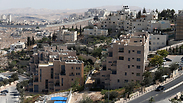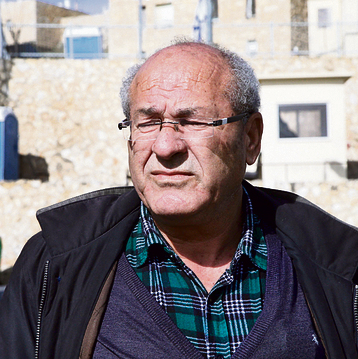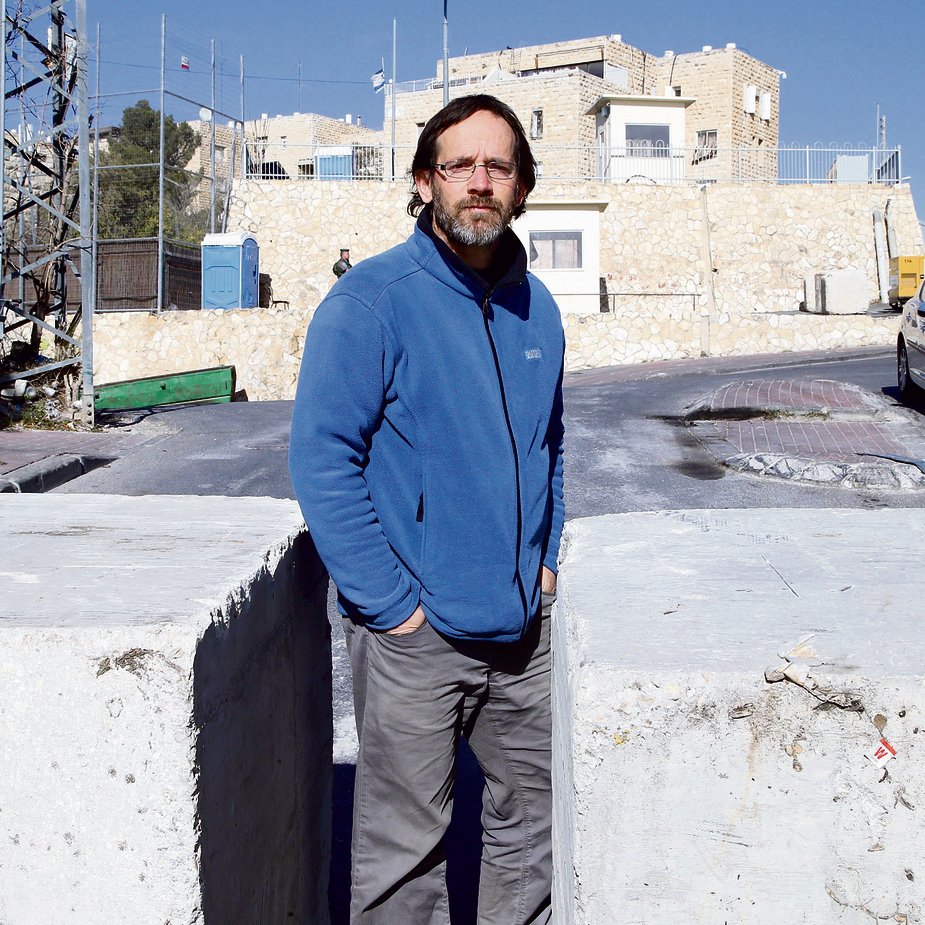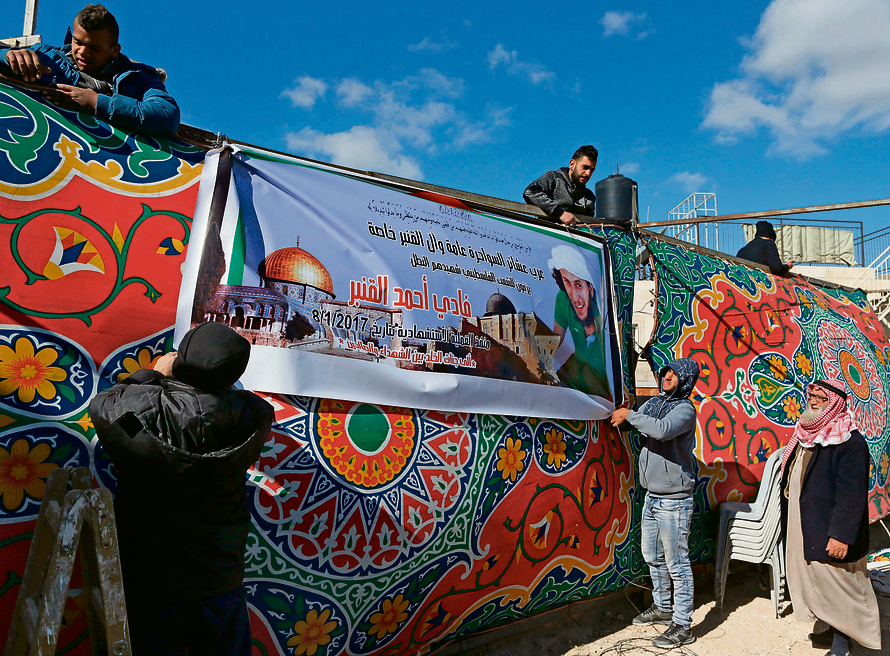
How Jabel Mukaber became a terror incubator
Fadi Qunbar, who murdered an IDF officer and three cadets in the East Talpiot vehicular attack, lived not far from the two cousins who murdered five worshippers and a policeman at a Jerusalem synagogue in 2014. As the villages annexed to Jerusalem in 1967 produce more and more terrorists, there is a growing demand to separate them from the city. But according to local resident Mahmoud Awisat, the solution begins with providing basic services to the neglected neighborhoods.
We came down from Shakirat Street, a two-way street which is only 3 meters wide. It has no pavement for pedestrians and it is strewn with potholes that are still filled with rainwater. The residents’ homes are built directly on the street, and any attempt to maneuver so that two vehicles facing each other would be able to pass is hopeless.

Green Hamas flags were raised over electric wires, and the police prevented anyone who is not a neighborhood resident from entering.
Later, when we left the neighborhood and drove towards the East Talpiot promenade, it took us less than five minutes, including all the curves and slow traffic in the crowded streets. Qunbar, who had recently become more religious and watched Islamic State videos, maneuvered his Mercedes truck out of his village, and as soon as he saw the well-kept homes of the nearby East Talpiot neighborhood, all he had to do was step on the gas and direct the vehicle towards a group of cadets.
Qunbar, who murdered an IDF officer and three cadets and wounded 15, lived not far from Ghassan and Uday Abu Jamal, who carried out the terror attack at the Kehilat Bnei Torah Synagogue in Jerusalem’s Har Nof neighborhood in November 2014. Using a gun, a knife and an axe, they murdered five worshippers and a policeman, before being killed. A year later, their cousin, Alaa Abu Jamal, murdered an Israeli citizen in west Jerusalem by running him over and beating him with an axe. Alaa Abu Dahim, who lived on the other side of the village, carried out the attack at the Mercaz Harav Yeshiva in March 2008, which left eight students dead. Bahaa Alian and Bilal Ghanem, who murdered three citizens in an attack on bus No. 78 in Jerusalem’s Talpiot neighborhood, were also born in the village and lived there.
This is only a partial list. In the past two years, terrorists have also come out of Beit Hanina, the Shuafat refugee camp and Sur Baher. Sixty percent of the terror attacks that have taken place in Jerusalem in the past two years originated in those villages. Detention operations in these neighborhoods, which are under full Israeli sovereignty, are carried out like military operations for all intents and purposes. On the background of the growing riots, stone and Molotov cocktail throwing and murderous attacks, the east Jerusalem issue is becoming more acute.
Classrooms inside apartments
About 30,000 people live in Jabel Mukaber, originally a Bedouin village which turned into a Jerusalem neighborhood after the Six-Day war. A depressing slum with garbage spilling over from dumpsters all over the streets, with no playgrounds and no green areas, with a shortage of classrooms and kindergartens, with one high school for boys which was opened only two years ago after 20-year pleadings from the residents. They pay taxes to the state and property tax to the municipality, but don’t seem to be getting anything visible in return.
While 36 percent of schoolchildren in Jerusalem are from the eastern part of the city, the eastern neighborhoods suffer from a shortage of 2,247 classrooms. Jabel Mukaber alone has a shortage of some 100 kindergarten and school classrooms. According to the village’s parents’ committee, about 40 percent of children drop out of school before completing 12 years of studies.
Mahmoud Awisat, a 40-year-old father of six and a member of the parents’ committee, says there are several reasons for the high dropout rate. “It’s the economic situation at home which sends children out to work, but it’s also the high density in the classrooms or the fact that there is no futsal court or a playground with equipment. I pay property tax like any other Jerusalem resident, but my children don’t study in normal schools. They study in apartments which are rented by the municipality and called a school.”
We met at the of al-Madaras Street, the street of the village’s schools. Several hours after Sunday’s terror attack, the police placed six concrete blocks along the road, which one can only pass through by foot. At around 8 am, they cause traffic congestions which jam the entire village, making it impossible for the children to reach the school down the road via transportation. Patients who have to reach the Clalit Health Services clinic, located about 100 meters from the blockage, are forced to walk too.
The clinic’s manager, Dr. Mahmoud al-Sabih, says the collective punishment increases the residents’ frustration. “It only adds problems,” he says, breathing heavily after walking up the road to the service taxi which is supposed to take him to a patient for a house call. “Think about elderly people, sick people, who can only reach the blocks by car and then have to continue by foot. They can’t walk this distance, let alone climb back from the clinic over here and wait for the car to come pick them up. People are asking themselves, ‘For how long will we keep suffering?’”
The street has nine schools and kindergartens that serves 3,000 children from across the village, which is defined by the municipality as a neighborhood. We took a tour in Awisat’s car. The writing “The street of the shahidim (martyrs) – Fadi Qunbar” was spray-painted last week on a wall in the boys’ high school. Not far from the school stands a dumpster. It is overflowing with garbage and surrounded by garbage from every direction. We spotted three dumpsters packed with garbage one after the other, and then we stopped counting. At the bottom of the street, Awisat drove around a large hole that had opened in the middle of the road. “How much will it cost the municipality to deal this hole?” he asked. “Maybe NIS for the stuff and another NIS 300 to do the work.”
Aviv Tatarsky, a researcher for Ir Amim, an NGO working for an egalitarian political future in Jerusalem, says the organization petitioned the High Court of Justice together with residents from Kafr ‘Aqab, a village located beyond the separation barrier which has remained part of Jerusalem’s municipal territory, over the municipality’s failure to build roads and install sewage infrastructures inside the neighborhood.
“In November 2015, the court ruled that the municipality must fulfill its obligation to the residents, and gave it nine months to conduct the work,” he says. “Fifteen months have passed since then, and nothing has happened.”
Elad Malka, a Likud activist from Jerusalem, who served as a city councilman up until seven months ago on behalf of the Hitorerut movement, says that the gap in infrastructure in the Arab neighborhoods amounts to some NIS 2.5 billion (roughly $650 million).
“The State of Israel is not fulfilling its responsibility in the eastern part of the city,” he says, “neither in education nor in health, sewage and water infrastructure or police enforcement. Hitorerut has managed to add NIS 3 million for sanitation in east Jerusalem, but that’s clearly not enough. More has to be done to narrow the gaps, to allocate more resources to the Arab neighborhoods, precisely because the property tax collection rates in those neighborhoods are not bad.
“But it’s not just the infrastructure. I was in charge of the youth portfolio in the municipality, and I had quite a few meetings with east Jerusalem residents. In one of them, an At-Tur resident told me about the time he saw his son being beaten and called the police, and they didn’t show up. The next time, he saw drugs being sold near his house, called the police, and again they didn’t show up. Several weeks later, the police were the ones who called him after his son was arrested for stone throwing. The way they see it, the police only defend the Jews and see them, the residents of east Jerusalem, as enemies.”
Awisat supports Malka’s comments. “The police are good when they serve the public, but here we have many times seen policemen grabbing small children playing on the street and pinning them to a wall in order to conduct a search on them. There was nothing that justified a search, because there was no stone throwing earlier.
“Take, for example, the blockage they created here. What is it good for? If someone wants to throw stones or firecrackers, will that stop him? On the contrary. Not only does it not deter, it incites. The village isn’t even closed. I can get anywhere in the western part of the city from other places. And you know where they’ll put these blocks a few days from now, when they decide that we have been punished enough? There,” he says, pointing to the nearby pavement. “They will move them, but they want take them away, so that we are reminded of what might happen if there are more problems here.”
Leverages of pressure
About a year ago, the government approved a budgetary increment for the recruitment of 1,260 police officers to the Jerusalem district. The police are supposed to receive the additional manpower gradually over the next six years. Most of the recruited police will be stationed in the east Jerusalem neighborhoods.
A senior source in the Jerusalem district says the police are working to increase the residents’ trust: “Five new police spots are being planned inside the eastern neighborhoods. We will implement an innovative model called local service center. Apart from police officers, it will also include the offices of authorities like the Jerusalem Municipality, the National Insurance Institute and the Interior Ministry. There will also be a medical emergency center which will be active at night. It’s a dramatic matter. The police officers stationed there will be communal police. They won’t hand out fines and won’t carry out arrests, so as not to be perceived as the bad cops. The first station is supposed to open in Sur Baher, and we have already located a building for it. If that goes well, we’ll continue in other neighborhoods too.”
The senior police source does not see the blockage in the school street as a collective punishment. He says it was an attempt to turn the local residents into part of the effort to prevent disturbances.
“The roadblock was placed there after firecrackers were thrown from that street at a television crew and at a police force. The blockage is part of the investigative effort to reach the people who threw the firecrackers. By closing the street, we created pressure, and that pressure drove an internal movement that led to the arrest of three suspects, who led us in their interrogation to seven other suspects.
“Last summer, we had an incident of a terrorist with an explosive device on Jaffa Street in central Jerusalem, and we closed part of the street for several hours. We shut down businesses, stores, cafés. None of the residents referred to it as collective punishment. We engage in pure operational decisions, not in punishment.
“There’s another issue here, which is to motivate the residents to get socially involvement. Our statement is that we have no intention of chasing every child who throws stones. That’s a lost battle. But if a child comes with a stone to a street corner and waits for a police car to drive by in order to throw stones at it, there is someone who sees him arriving with the stone and waiting to throw it. There is someone who sees him throwing the stone and escaping, and there is someone who sees where he escaped to. We want to create a situation in which the population itself will prevent such incidents. How do we do it? We get the people there involved in the incident. We go and question all the business owners in the area, we go from house to house and search, asking questions. We basically ‘move’ the neighborhood.”
This model, Jerusalem Police sources say, has led to a significant drop in the number of stone, Molotov cocktail and firecracker throwing incidents, as well as in the number of incidents of blocking roads with rocks or tires. In 2016, there was a 63 percent drop in the number of disturbances recorded in east Jerusalem compared to 2015. The police’s attitude towards the residents changed as well.
“We have to let the population in the eastern part of the city understand that the police are not only offensive,” says the senior officer. “The majority of the population is normative, so we have instilled in the police officers an attitude of respect for people. People who are asked to stop for a police check are then released with a handshake if everything is fine with them. With a pat on the shoulder, without cursing, without inappropriate words or humiliation. That is a dramatic change too, and it’s part of the knowledge that most residents want to live their life in peace.”
But the reality is far from being ideal. Former Councilman Malka says that the void created by Israel in Jerusalem’s eastern neighborhoods attracts terroristic elements. “There are already outposts of Hamas and the Palestinian Authority in some of the places, if not in all. There are Hamas-funded Scouts, and other PA-sponsored activities. We cannot keep ignoring east Jerusalem.”
In 1967, east Jerusalem included only six neighborhoods on an area of about 6 square meters (10.5 square feet). At the end of the war, the Israeli government decided to add an additional 64 square meters (690 square feet) to the city, including 22 villages which had not been part of Jerusalem until then. Jabel Mukaber was one of them.
Today, there are 305,000 Palestinians living in the Jerusalem municipal areas. They make up 37 percent of the city’s population, but receive only 10 percent of the municipality budget. The Arab population’s part in the welfare, sports and youth advancement budgets is only 5 percent. The figures tell the entire story of the neglect: From 1967 to 2012, only 4,300 building permits were handed out in east Jerusalem’s Palestinian neighborhoods. This led to a culture of illegal construction, which is estimated today at tens of thousands of housing units. Only 64 percent of the households in these neighborhoods are properly connected to the water system. In fact, the Arab parts of east Jerusalem are 30 kilometers (18.5 miles) short of water pipes.
We traveled together to look at the project built in the northern part of the neighborhood, which is called Nof Zion. It includes 90 apartments in terraced buildings for Jews only. It has a playground with fancy equipment, surrounded by a high fence. Awisat says that last month the municipality approved the construction of a mikveh (ritual bath) and a synagogue in Nof Zion, “and all that from the property tax we pay. It’s a settlement inside our neighborhood, which just goes to show that we are not of equal status.”
Later, as we drove from Jabel Mukaber to Silwan and passed through Ein al-Luza Street, we were greeted by children playing next to a wall with a huge graffiti marking Hamas’ 29th anniversary. Above them, we saw Hamas flags raised over the electricity cables crossing the street. Another neglected, dirty street, full of holes. Demolition orders have been issued against 100 apartments on this street.
There are those who are looking to take this nuisance off Israel’s back through a separation barrier. The Save Jewish Jerusalem movement is leading the idea of separating from the Arab neighborhoods in the eastern part of the city. The initiative includes the construction of a fence which will leave most of the villages annexed to Jerusalem outside the city, including Sur Baher, Jabel Mukaber, Beit Hanina, Isawiya and the Shuafat refugee camp. These areas will become part of Area B or C, and the civilian responsibility for them will be handed over to the PA. The security control will remain in Israel’s hands.
Former Minister and Knesset Member Haim Ramon, one of the leaders of the initiative, says there is no escape from this move. “Abu Dis is already part of Area B, and the PA is active there with police and government ministries,” he says. “And Abu Dis is located 2 kilometers from the Western Wall. If the PA refuses to take responsibility for these areas, we will declare them part of Area C and they will be managed like an Area C in the West Bank. There are 100,000 Palestinians living in Areas C today. Doesn’t anyone care for them?
“Such a move will change the entire picture. The international community doesn’t recognize our sovereignty there anyway, so it’s not like we’ll be condemned for such a move. I believe that the international community will invest a lot of money in improving the horrible situation that we will leave there. If we want a Jewish majority in Jerusalem in 10-20 years from now, we must go for this move. It is required from a security aspect as well. When we fought for the separation barrier, we were told by the Right that it won’t help. Today, we know that it did help. It helped big time.”
Tatarsky from Ir Amim sees it as a delusional idea. “Of course we would like the PA to take responsibility for these villages and neighborhoods, but the PA also understands that the entire deal here is throwing a weak and poor population at them. Why should they help us deal with this headache without getting al-Aqsa, without a peace agreement that solves the entire Jerusalem issue? The PA knows that if it becomes part of such a move, without an agreement, it will lose the little legitimacy it still has on the Palestinian street.”
At the end of the day, we stood with Mahmoud Awisat next to the concrete blocks. We told him about the initiative to surround his village with a fence and remove Israel’s responsibility for it. Instead of tiny budgets, we told him, you will receive nothing.
“It doesn’t work that way,” he replied. “How will they do such a thing? Can they just play with people’s lives that way? You have to understand that we are not indifferent to the neglect and to the fact that we are being treated like enemies. Of course people do something. This neglect doesn’t allow us to guide our children to a normal life. What will we say to our children? Go play soccer in the field? Go swing in the playground? So the children are constantly on the roads or in front of the television or the Internet, seeing everything that is happening around them. It gives people ideas. You don’t know what a person thinks or dreams at night and what he will do with it in the morning. Instead of thinking about a fence, start thinking about what we are entitled to, the basic things. You know, a school, a small garden, normal roads and pavements, like in the western part of the city.”
‘Mayor Barkat is narrowing the gaps’
The Jerusalem Municipality offered the following response: “Jerusalem Mayor Nir Barkat has been leading in the past few years a comprehensive move to narrow the gaps in Jerusalem’s Arab neighborhoods. During the Barkat era, more than 800 new classrooms have been built in the eastern part of the city, and an additional 1,000 are in the planning and implementation stages. Some of the country’s most advanced technological schools have been built, two new communal administrations have been opened, dozens of roads have been built and paved at an investment of hundreds of millions of shekels, and large budgets are invested in improving the municipal services, opening infant welfare centers, providing welfare and community services, postal services, etc. In addition, many sports fields have been upgraded, an employment center has been built in Shuafat, etc. Furthermore, in the past two years the municipality has been implementing a long school day project in east Jerusalem’s high schools until 5:30 pm.
“Unfortunately, the gap bridging momentum is reflected primarily in the neighborhoods located within the security fence, rather than in those beyond the fence, due to the security challenge and the need for the security forces’ help in operating in those neighborhoods. The municipality uses every opportunity it has to raise the issue with the senior political echelon in order to lead an outline that would allow it to provide services and municipal enforcement on a regular basis in those neighborhoods as well.”














